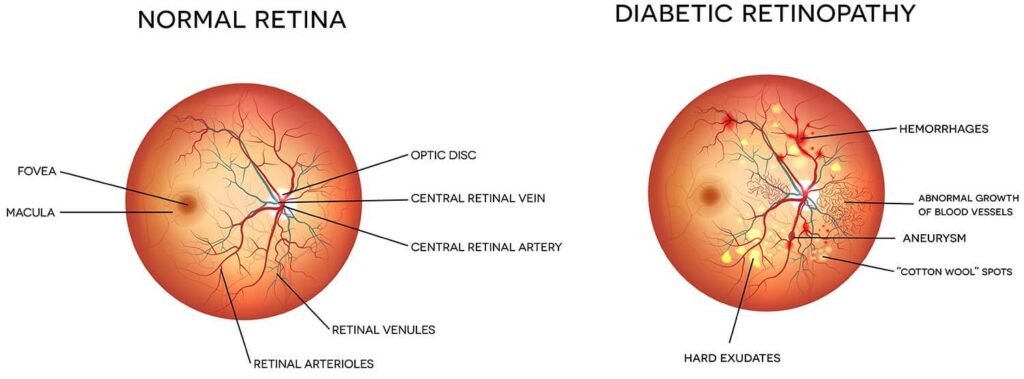What is diabetic retinopathy?
Diabetic retinopathy affects the small blood vessels in the retina, which is found at the back of the eye. This causes swelling and weakening of the retinal blood vessels, which can lead to blood and other liquid leaking into the retina. If fluid leaks into the center of the eye, you may have blurry vision. If blood sugar levels stay high, diabetic retinopathy continues to worsen. New blood vessels grow on the retina, but they are weak and break easily. This bleeding affects vision, but can also create scar tissue that can pull on the retina and cause detachment. Diabetic retinopathy can also cause the macula, the middle of the retina that lets you see detail, to swell. This can lead to blindness.

What are the symptoms of diabetic retinopathy?
Patients with diabetic retinopathy often have no symptoms, especially if blood only leaks into the retina and not the center of the eye. Often when symptoms such as changing vision do occur, it is too late to prevent many of the consequences. That’s why a yearly eye exam is crucial for all people, but particularly those with diabetes. Dr. Sweeney can identify diabetic retinopathy in its earliest stages and that will affect the progression of the disease and can head off vision loss.
How do you prevent diabetic retinopathy?
While there is no foolproof method of prevention, three steps can make a big difference.
- Control your blood sugar levels. Eat a healthy diet and monitor your blood sugar levels. Get exercise. Take insulin or other medications if you have type 2 diabetes.
- Control your blood pressure. Retinopathy is more likely to progress to more severe levels, including macular edema (swelling of the macula), in those with high blood pressure. Keep your blood pressure in the target range.
- Get yearly eye exams. Screening will not prevent diabetic eye disease, but it will result in early detection and treatment to help you avoid vision loss.
What are the available treatments for diabetic retinopathy?
The best treatment for diabetic retinopathy is to keep your diabetes and blood pressure under control. However, our doctors perform laser photocoagulation, which seals leaking retinal blood vessels and prevents the growth of new ones. If blood is leaking into the vitreous humor of the eye, we may suggest a procedure known as a vitrectomy. You will know more about your diabetic retinopathy treatment options on your initial consultation with us.

